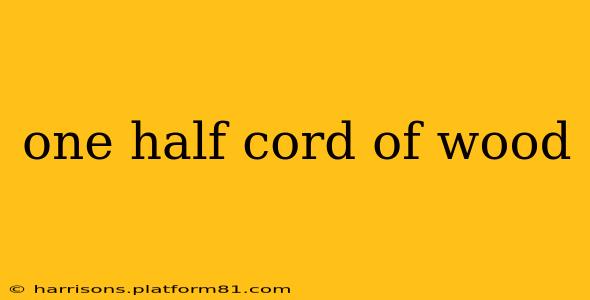Buying firewood can be confusing, especially when dealing with measurements like a "half cord." Understanding what a half cord of wood entails is crucial to avoid overpaying or receiving less wood than you bargained for. This guide will clarify the dimensions, volume, and practical considerations of a half cord of wood.
What is a Half Cord of Wood?
A half cord of wood, also known as a "face cord" in some regions, represents exactly half the volume of a full cord. A full cord is a standard measurement of stacked firewood, equaling 128 cubic feet. Therefore, a half cord of wood is 64 cubic feet. It's important to note that this is the volume of the wood after it's neatly stacked. Loosely piled wood will occupy a much larger space.
What are the Dimensions of a Half Cord of Wood?
The dimensions of a half cord aren't fixed; the crucial factor is the total volume. However, a common way to visualize a half cord is a stack measuring 4 feet wide x 4 feet high x 2 feet deep. This stack results in 32 cubic feet. To achieve a full half-cord of 64 cubic feet, you would simply need to double the depth to 4 feet (4ft x 4ft x 4ft). Other dimension combinations can also achieve 64 cubic feet.
How Much Space Does a Half Cord of Wood Take Up?
The space a half cord occupies depends entirely on how neatly the wood is stacked. A tightly stacked half cord will occupy a smaller footprint than one that is loosely piled. The example dimensions (4ft x 4ft x 4ft) give you a good idea of the space required, but expect some variation.
How Much Heat Does a Half Cord of Wood Provide?
The heat output of a half cord depends on several factors, including the type of wood, its moisture content, and the efficiency of your stove or fireplace. Generally, denser hardwoods like oak or maple will produce more heat than softer woods like pine. Dry wood is crucial for efficient burning and heat generation. A well-seasoned half cord should provide a significant amount of heat for a heating season, though the exact duration varies based on usage.
How Long Will a Half Cord of Wood Last?
The lifespan of a half cord depends on factors such as the size and efficiency of your wood-burning appliance, the frequency of use, and the type of wood. A family using a wood-burning stove as their primary heat source might burn through a half cord in a matter of weeks during the coldest months, whereas someone using a fireplace occasionally might find a half cord lasts for much longer.
Is a Face Cord the Same as a Half Cord?
The term "face cord" is often used interchangeably with a half cord, but this can be misleading. A face cord typically refers to a stack of wood that is 4 feet high and 8 feet long, but the depth can vary significantly. Therefore, a face cord is not always a true half cord of 64 cubic feet. It's crucial to clarify with the seller exactly what dimensions are included in their definition of "face cord."
How Much Does a Half Cord of Wood Cost?
The price of a half cord of wood fluctuates based on location, type of wood, delivery costs, and market demand. You'll find pricing ranges widely depending on these factors. It's wise to contact multiple suppliers in your area to compare prices and ensure you're getting a fair deal.
In conclusion, understanding the nuances of a half cord of wood is essential for making informed decisions when purchasing firewood. Remember to clarify dimensions and stacking methods with your supplier to ensure you receive the amount of wood you expect. Always prioritize purchasing well-seasoned wood for optimal heat output and efficiency.
